Download PDF
Download page Longwave Radiation.
Longwave Radiation
All living and non-living bodies emit Longwave Radiation. The magnitude of the radiation is proportional to the temperature (measured in Kelvin degrees) of the body raised to the fourth power. Significant sources of longwave radiation in hydrologic applications include the atmosphere itself, and any clouds that may be present locally in the atmosphere. Clouds usually have a higher heat content and higher temperature than clear atmosphere, and therefore there is increased downwelling longwave radiation on cloudy days. Whether the atmosphere and clouds are a net source of longwave radiation to the land surface depends on their temperature relative to the land surface temperature. In most cases, the net longwave radiation is incoming during the daylight hours, and outgoing during the night hours.
The Longwave Radiation Method included in the Meteorologic Model is only necessary when Energy Balance Methods are used for Evapotranspiration or Snowmelt. The options available cover a range of detail from simple to complex. Simple specified methods are also available for input of a time-series or grid. Each option produces the Downwelling Longwave Radiation arriving at the land surface. Downwelling Longwave Radiation has a positive sign convention in HEC-HMS. Absorption and radiation by the land surface is computed within the Subbasin Element. More detail about each method is provided in the following sections.
FAO56
The FAO56 Method implements the algorithm detailed by Allen, Pereira, Raes, and Smith (1998). The algorithm calculates the solar declination and solar angle for each time interval of the simulation, using the coordinates of the subbasin, Julian day of the year, and time at the middle of the interval. The solar values are used to compute the clear sky radiation for each subbasin. The computed shortwave radiation is then divided by the calculated clear sky radiation to estimate the fraction of shortwave radiation reaching the ground. Finally, the fraction of shortwave radiation reaching the ground is combined with the vapor pressure to calculate a reduction to the downwelling longwave radiation based on the Stefan-Boltzmann equation.
The FAO56 Method includes a Component Editor with parameter data for all subbasins in the Meteorologic Model; the same data is also shared with the FAO56 Shortwave Radiation Method. When FAO56 is used for both shortwave and longwave radiation, the icon will preferentially show the Shortwave icon. A Component Editor is also included for each subbasin. The Watershed Explorer provides access to the Longwave Component Editors using a picture of cloud black body radiation.
Temperature (or Dew Point Temperature) and a Windspeed methods must be selected in the Meteorologic Model. Actual Vapor Pressure is used as a humidity correction for emitted longwave radiation. Actual vapor pressure can be calculated using the Dew Point Temperature, Relative Humidity, or Daily Minimum Temperature. The Daily Minimum Temperature option should be used when relative humidity or dewpoint data are not available; the daily minimum temperature option assumes the dewpoint temperature is equal to the daily minimum temperature.
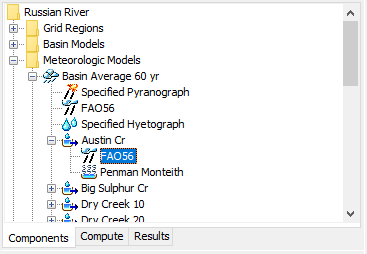
A Component Editor for all subbasins in the Meteorologic Model includes the Central Meridian of the Time Zone. There is currently no specification for the time zone so the meridian must be specified manually. The central meridian is commonly the longitude at the center of the local time zone. Meridians west of zero longitude should be specified as negative while meridians east of zero longitude should be specified as positive. The meridian may be specified in decimal degrees or degrees, minutes, and seconds depending on the Program Settings.

The Component Editor for each subbasin in the Meteorologic Model is shown below. Currently, the only method for calculating the differences from clear sky radiation is based on elevation. A Representative Elevation should be entered for each subbasin.

Gridded Longwave
The most common use of the method is to utilize gridded longwave radiation estimates produced by an external model, for example, a dynamic atmospheric model. If a gridded longwave radiation estimate is used with a transform method other than ModClark, an area-weighted average of the grid cells in the subbasin is used to compute the longwave radiation time-series for each subbasin.
The Gridded Longwave Method includes a Component Editor with parameter data for all subbasins in the Meteorologic Model. The Watershed Explorer provides access to the Longwave Component Editor using a picture of downwelling radiation from clouds.
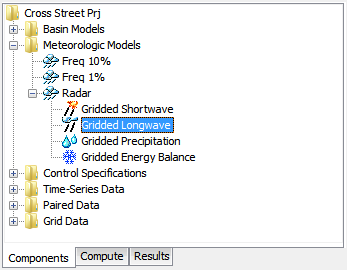
A Component Editor for all subbasins in the Meteorologic Model includes the selection of the data source. A Radiation Gridset must be selected for all subbasins. The current gridsets are shown in the selection list. If there are many different gridsets available, you may wish to choose a gridset from the selector accessed with the Grid button next to the selection list. The selector displays the description for each gridset, making it easier to select the correct one.
Satterlund
The Satterlund Method (Satterlund, 1979) uses temperature and vapor pressure to estimate incoming longwave radiation. While certain physical limits are enforced, the approach is fundamentally empirical. It provides good estimates under mostly clear skies and continues to perform well even as temperature drops below the freezing point. It has the advantage of requiring only readily available meteorologic data.
The Satterlund Method includes a Component Editor with parameter data for each subbasin in the Meteorologic Model. The Watershed Explorer provides access to the Longwave Component Editors using a picture of downwelling radiation from clouds.
Temperature, Windspeed, and Dew Point methods must be selected in the Meteorologic Model.

The Incoming Longwave Radiation is computed using a modified form of the equation for ideal black body radiation. The Emissivity is calculated as a function of the temperature, where the Temperature Coefficient has a default value of 2016 Kelvin. An Emissivity Coefficient is included for calibration, though the default value of 1.08 is widely used. The Emissivity and Temperature Coefficients can be entered in the Component Editor as shown in the following figure.
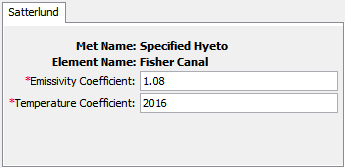
Specified Pyrgeograph
A Pyrgeometer is an instrument that can measure Downwelling Longwave Radiation. They are not part of basic meteorological observation stations, but may be included at first-order stations. This method may be used to import Observed Values from a Pyrgeometer or it may be used to import estimates produced by an external model.
The Specified Pyrgeograph Method includes a Component Editor with parameter data for all subbasins in the Meteorologic Model. The Watershed Explorer provides access to the Longwave Component Editors using a picture of downwelling radiation from clouds.
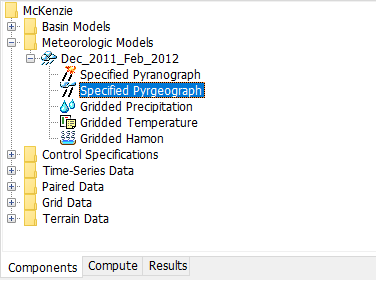
The Component Editor for all subbasins in the Meteorologic Model includes the Time-Series Gage of Longwave Radiation for each subbasin. A Radiation Gage must be selected for a subbasin. The current gages are shown in the selection list.

Interpolated Longwave
Gridded data better captures the meteorology temporally and spatially across a watershed when compared to gage measurements at a single point. However, hourly or sub-hourly gridded meteorology products are not always available, particularly for historic events of interest to the modeler. In these cases, a gridded dataset can be created by interpolating point observations recorded at weather stations. The Interpolated Longwave Method allows the user to develop an interpolated longwave radiation grid based on point radiation gage data.
The Interpolated Longwave Method includes a Component Editor with parameter data for all subbasins in the Meteorologic Model. The Watershed Explorer provides access to the Longwave Component Editor. The Component Editor for each subbasin in the Meteorologic Model is used to enter parameter data that defines the Interpolation Method and to select radiation gages to use in the interpolation. The Interpolation Method can be selected from the dropdown menu. An interpolation method must be selected. The user has four interpolation options briefly summarized below.
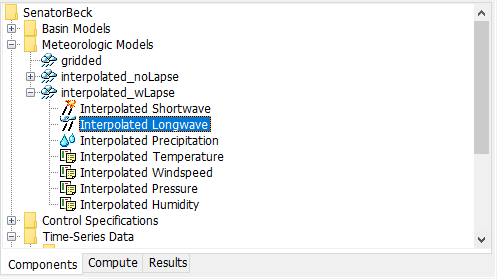
The Inverse Distance interpolation method assumes the weight, or influence, of a gage is equal to the inverse of its distance from the interpolated cell. The Inverse Distance Squared interpolation method assumes the weight of a gage is equal to the inverse of the square of its distance from the interpolated cell. The Nearest Neighbor interpolation method simply assigns the nearest value to the cell center of interest without considering values of other nearby points. Bilinear interpolation within HEC-HMS relies on triangulation of the irregularly spaced gage locations. Based on the gage coordinates, a Triangulated Irregular Network (TIN) is created to represent the gage network in the basin model coordinate system. This TIN defines triangles, where each gage is a corner of one or more triangles. Given this TIN, a value at any given point is computed by first identifying the triangle in which that point falls, then interpolating within that triangle using Barycentric Coordinates. You must use three or more gages and the gages need to bound all grid cells.
Select Radiation Gages in the dropdown rows under the Gage column. The Radius of Influence is an optional parameter and represents the maximum interpolation distance. Beyond its radius of influence, the gage will not affect the cell values of the interpolated grid. Radiation Gages used in this method must be loaded in as Time-Series of Radiation Data with defined latitude and longitude information.

An interpolated longwave radiation grid will be created once the simulation has been computed. Once the compute is complete the interpolated grid will be saved with the same name as the Meterologic Model in DSS format in the HEC-HMS project directory.
Stefan Boltzmann Longwave
The Stefan Boltzmann Longwave Method implements the longwave radiation algorithm described within TVA (1972) and Follum et al. (2015). The method estimates the amount of longwave radiation at a specific location (grid cell or subbasin) using the air temperature and relative humidity. As such, this method requires the use of a valid temperature and relative humidity method.
The Stefan Boltzmann Longwave Method includes a Component Editor with parameter data for all subbasins in the Meteorologic Model. The Watershed Explorer provides access to the Stefan Boltzmann Longwave Editor using a picture of downwelling radiation from clouds.

The Stefan Boltzmann Longwave Component Editor is shown in the following figure. The user must select an atmospheric emissivity and saturation vapor pressure method. Currently, only the Bras (1993) option is available for the Atmospheric Emissivity Method. This method computes atmospheric emissivity from relative humdiity and saturation vapor pressure. Additional options will be added in the future. There are two options for the Saturation Vapor Pressure Method: Smith (1993) and FAO56 (1998). The FAO56 (1998) method uses the Clausius-Clapeyron equation to compute saturation vapor pressure from air temperature.
